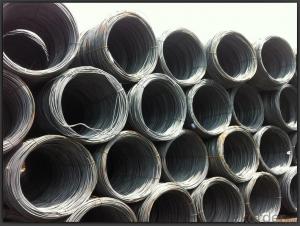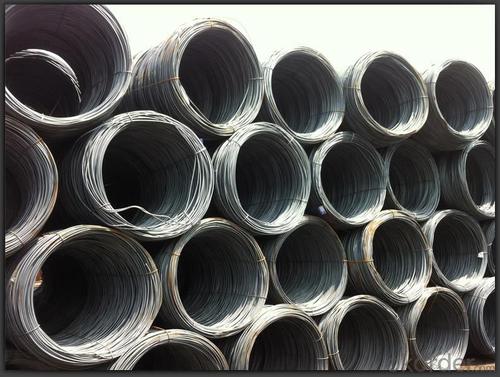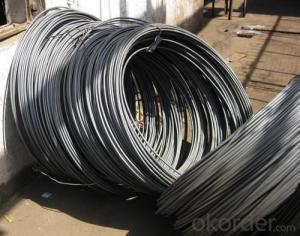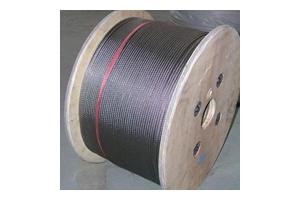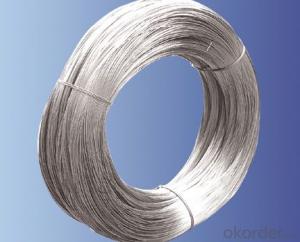Mild Steel Wire Rod_12mm
- Loading Port:
- China Main Port
- Payment Terms:
- TT OR LC
- Min Order Qty:
- -
- Supply Capability:
- -
OKorder Service Pledge
OKorder Financial Service
You Might Also Like
Specifications of Steel Wire Rod in Coil:
Steel Grade: Q195/235, SAE1006-1018B Standard: ASTM, GB
Diameter: 6.5mm
Type: Drawn Wire Alloy or Not: Alloy
Technique: Hot Rolled
Chemical Composition:
Grade | Chemical Composition (%) | |||||
C | Mn | S | P | Si | B | |
SAE1006B | 0.03~O.07 | 0.32max | 0.045max | 0.040max | 0.30max | 0.0008min |
Mechanical properties | ||||||
Yield strength(N/mm2) | Tensile strength(N/mm2) | Elongation (%) | ||||
250-280 | 350-380 | ≥32 | ||||
Grade | Chemical Composition (%) | |||||
C | Mn | S | P | Si | B | |
SAE1008B | 0.10max | 0.3~0.50 | 0.050max | 0.040 max | 0.15max | 0.0008 min |
Mechanical properties | ||||||
Yield strength(N/mm2) | Tensile strength(N/mm2) | Elongation (%) | ||||
≥195 | 315-430 | ≥30 | ||||
Note:
1. Our products are produced according to national standard (GB), if not, supply according to national standards (GB) or agreement as customer required.
2. Other Grade and Standard carbon steel wire rod we can supply:
Grade: H08A, 30MnSi, 62B-82B
Standard: AISI, BS, JIS, DIN
The Minimum Order Quantity of these products is high, and need to be confirmed.
3. We can not only supply carbon steel wire rod; if you need anything about building materials, please contact us.
4. Please send us your detail specifications when inquire. We will reply to you as soon as possible. We sincerely hope we can establish a long stable business relationship.
- Q: How are steel wire rods used in the manufacturing of fishing nets?
- The manufacturing of fishing nets relies heavily on steel wire rods, which are indispensable components. These rods form the framework of the net, offering the necessary strength and endurance to withstand the harsh fishing environment. To initiate the manufacturing process, the steel wire rods go through straightening and cutting, resulting in various lengths depending on the desired net size. These rods are then woven or knotted together, ensuring a tight weave that guarantees the net's sturdiness and resistance to breakage or tearing when catching fish. The selection of steel wire rods for fishing nets is based on their exceptional tensile strength and resistance to corrosion. These qualities are crucial as fishing nets are predominantly used in marine environments, where saltwater can be corrosive. Moreover, the steel wire rods are often coated with protective layers like zinc or PVC to further enhance their durability and prevent rusting. Additionally, the flexibility of steel wire rods allows fishing nets to adapt to different shapes and sizes. This flexibility is paramount as it enables the net to conform to the water's contours, maximizing its efficiency in capturing fish. In conclusion, steel wire rods play a vital role in the manufacturing of fishing nets by providing the necessary strength, durability, and flexibility. Their remarkable tensile strength and corrosion resistance make them ideal for enduring the harsh conditions of fishing. Without these steel wire rods, the manufacturing of fishing nets would be impossible, greatly impacting the fishing industry.
- Q: How is steel wire rod used in the production of wire mesh for erosion control?
- Steel wire rod is used in the production of wire mesh for erosion control as it serves as the primary material for creating the mesh structure. The steel wire rod is first processed and shaped into thin, continuous wires. These wires are then woven or welded together to form a mesh pattern, which provides strength, stability, and durability to the wire mesh. This mesh is crucial in preventing soil erosion by acting as a barrier and retaining the soil in place, thereby protecting slopes, embankments, and other vulnerable areas from erosion caused by water or wind.
- Q: How is steel wire rod used in the production of wire mesh partitions?
- Steel wire rod is an essential component in the production of wire mesh partitions. Wire mesh partitions are commonly used in various applications such as industrial warehouses, commercial spaces, and even residential areas. Steel wire rod serves as the raw material for manufacturing the wire mesh used in these partitions. The wire rod is typically made of high-quality steel, which offers durability, strength, and resistance to corrosion. These properties are crucial for ensuring the longevity and reliability of the wire mesh partitions. To produce wire mesh partitions, the steel wire rod undergoes a series of manufacturing processes. First, the steel wire rod is drawn through a series of dies to reduce its diameter and increase its length. This process is called wire drawing and results in a thinner and longer wire, which is more suitable for weaving. Once the wire is drawn, it is then fed into a machine that weaves it into a mesh pattern. This weaving process can be done in various patterns, such as plain weave, twill weave, or Dutch weave, depending on the desired characteristics of the wire mesh partition. The weaving process interlocks the wires together, creating a strong and stable mesh structure. After the wire mesh is woven, it may undergo additional processes such as galvanization or coating to enhance its resistance to corrosion or provide a specific finish. Galvanization involves coating the wire mesh with a layer of zinc, which acts as a protective barrier against rust and other environmental factors. Once the wire mesh is ready, it is then cut, shaped, and assembled to form the partitions. The wire mesh is secured to a frame made of metal or other materials, creating a sturdy and secure partition system. These partitions can be customized to fit specific spaces and requirements, providing efficient storage, security, and separation of areas. In summary, steel wire rod is an integral component in the production of wire mesh partitions. It serves as the raw material for manufacturing the wire mesh and provides the strength, durability, and resistance to corrosion required for these partitions. Through various manufacturing processes, the steel wire rod is transformed into a woven mesh pattern, which is then shaped and assembled into wire mesh partitions for a wide range of applications.
- Q: What are the different types of surface finishes available for steel wire rod?
- Some common types of surface finishes available for steel wire rod include black oxide, galvanized, phosphatized, and bright.
- Q: What are the common production processes for high carbon steel wire rod?
- The common production processes for high carbon steel wire rod include hot rolling, heat treatment, and surface treatment.
- Q: How is steel wire rod used in the manufacturing of wire for solar panels?
- Steel wire rod is an essential component in the manufacturing process of wire for solar panels. The high-quality steel wire rods are first carefully selected for their strength, durability, and conductivity properties. These wire rods are then subjected to a series of manufacturing processes to transform them into the required wire for solar panels. The first step involves drawing the steel wire rod through a series of dies to reduce its diameter and increase its length. This process is known as wire drawing and is typically done using specialized machinery. By repeatedly passing the wire rod through smaller dies, the diameter of the wire is reduced while its length is increased. This results in a long, thin wire that is ideal for solar panel applications. Once the wire has been drawn to the desired diameter, it undergoes various treatments to enhance its performance and ensure its suitability for solar panel use. These treatments may include processes such as annealing, which involves heating the wire to high temperatures and then slowly cooling it down. Annealing helps to improve the wire's flexibility, strength, and electrical conductivity. After the wire has been treated, it is carefully inspected for any defects or imperfections. This quality control step is crucial to ensuring that the wire meets the stringent requirements of the solar panel industry. Any wires that do not meet the required standards are discarded, while those that pass the inspection are further processed. The final step involves coating the wire with a protective layer. This coating is usually made of materials like tin, silver, or copper, which provide corrosion resistance and enhance the wire's electrical conductivity. The coated wire is then wound onto spools or reels, ready to be used in the assembly of solar panels. In summary, steel wire rod is an integral part of the manufacturing process for wire used in solar panels. It undergoes various treatments, including wire drawing and annealing, to create a durable and highly conductive wire. By coating the wire with protective materials, its corrosion resistance and electrical properties are further enhanced. The resulting wire is then utilized in the construction of solar panels, helping to harness solar energy and contribute to a more sustainable future.
- Q: What are the different types of steel wire rod finishes available?
- There are several different types of steel wire rod finishes available, including bright finish, black finish, galvanized finish, and coated finish.
- Q: What are the different types of steel wire rod rolling processes?
- There are several different types of steel wire rod rolling processes, each with its own unique characteristics and advantages. Some of the most commonly used processes include: 1. Hot rolling: This is the most common method used to produce steel wire rods. In this process, the steel is heated above its recrystallization temperature and passed through a series of rolling mills to reduce its thickness and increase its length. Hot rolling results in a finer grain structure, improved mechanical properties, and a higher surface quality. 2. Cold rolling: This process involves passing the steel wire rod through a series of rolling mills at room temperature or below its recrystallization temperature. Cold rolling is typically used to produce smaller diameter wire rods with tighter tolerances and improved surface finish. It also provides higher strength and hardness compared to hot rolling. 3. Thermomechanical rolling: This process combines elements of both hot and cold rolling. The steel wire rod is heated to a temperature slightly above its recrystallization temperature and then rolled at a lower temperature. This allows for better control over the mechanical properties and microstructure of the wire rod, resulting in enhanced strength and toughness. 4. Controlled cooling rolling: In this process, the steel wire rod is cooled at a controlled rate after hot rolling. This controlled cooling helps to refine the microstructure and enhance the mechanical properties of the wire rod. It is commonly used to produce high-strength wire rods for applications requiring excellent fatigue resistance and durability. 5. Micro-alloyed rolling: This process involves adding small amounts of alloying elements, such as vanadium or niobium, to the steel wire rod before rolling. These alloying elements help to refine the grain structure and improve the mechanical properties of the wire rod, such as strength and toughness. Micro-alloyed rolling is often used to produce wire rods for high-stress applications, such as automotive and construction industries. Overall, the choice of steel wire rod rolling process depends on the desired properties and specifications of the end product. Each process offers distinct advantages and can be tailored to meet specific industry requirements.
- Q: What are the major risks and uncertainties in the steel wire rod industry?
- The steel wire rod industry, like any other industry, faces several major risks and uncertainties that can impact its growth and profitability. Some of the key risks and uncertainties in the steel wire rod industry include: 1. Fluctuating raw material prices: Steel wire rod production heavily depends on the availability and cost of raw materials such as iron ore and coal. Any significant price fluctuations in these inputs can impact the industry's profitability and competitiveness. 2. Global economic conditions: The steel wire rod industry is highly sensitive to global economic conditions. During periods of economic downturns or recessions, demand for steel products, including wire rods, tends to decline. Uncertain economic conditions, trade tensions, and geopolitical factors can create volatility and affect the industry's growth prospects. 3. Overcapacity: Overcapacity is a significant concern in the steel wire rod industry. Excess production capacity leads to intense competition, price wars, and lower profit margins. This can be exacerbated by subsidized production in certain regions, leading to unfair competition and market distortions. 4. Technological advancements: The steel wire rod industry needs to constantly adapt to technological advancements to remain competitive. The adoption of advanced manufacturing technologies, automation, and digitalization can improve efficiency and reduce costs. However, the industry must also manage the risk of disruptions caused by technological changes and ensure a skilled workforce to operate and maintain these technologies. 5. Environmental regulations: The steel wire rod industry is subject to strict environmental regulations due to its significant carbon footprint and resource-intensive production processes. Compliance with emissions standards, waste management, and sustainable practices can present challenges and additional costs for industry players. 6. Currency fluctuations: Steel wire rod is a globally traded commodity, and currency fluctuations can impact the industry's competitiveness. A strong domestic currency can make exports more expensive, reducing demand and market share. Conversely, a weak domestic currency can make imports more expensive, affecting the cost of raw materials and machinery. 7. Trade barriers and protectionism: The steel wire rod industry is particularly susceptible to protectionist measures such as tariffs, quotas, and anti-dumping duties. Trade disputes and barriers between major steel-producing countries can disrupt global supply chains, increase costs, and limit market access. In conclusion, the steel wire rod industry faces several risks and uncertainties that require proactive management. Adapting to technological advancements, monitoring global economic conditions, managing raw material costs, complying with environmental regulations, and navigating trade barriers are crucial for industry players to maintain their competitiveness and long-term sustainability.
- Q: How is steel wire rod used in the manufacturing of wire mesh fencing?
- Steel wire rod is used in the manufacturing of wire mesh fencing as it serves as the primary raw material for producing the wire mesh. The steel wire rod is first drawn into thinner strands and then woven or welded together to create the mesh pattern. This process ensures the strength and durability of the wire mesh fencing, making it suitable for various applications such as securing boundaries, protecting livestock, or enclosing outdoor spaces.
Send your message to us
Mild Steel Wire Rod_12mm
- Loading Port:
- China Main Port
- Payment Terms:
- TT OR LC
- Min Order Qty:
- -
- Supply Capability:
- -
OKorder Service Pledge
OKorder Financial Service
Similar products
Hot products
Hot Searches
Related keywords
